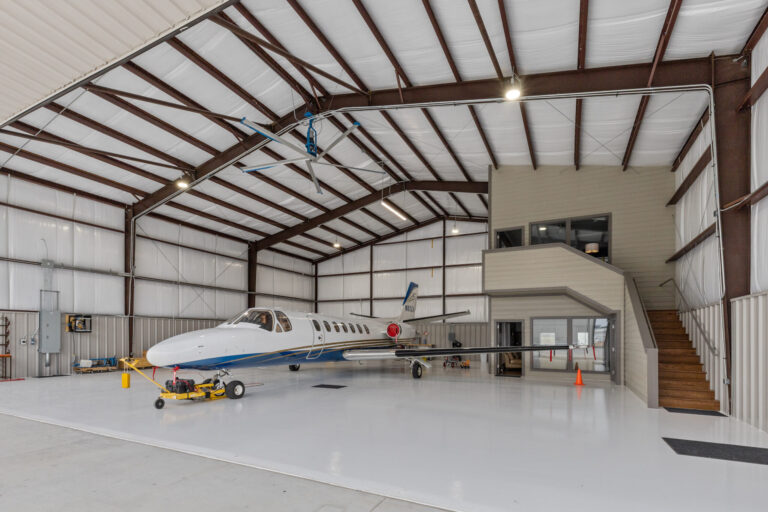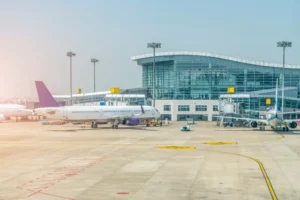NAVIGATING LEASING OF HANGARS IN KENYA
A hangar is a large building that is used for the storage of aircraft. Leasing of hangars is a common practice within the aviation industry. It is a facility that is highly significant to aviation operators since it reduces their cost of security. Kenya does not have specific laws governing hangars, and they mostly fall under the ambit of land law. This means that the regulations surrounding hangars depend on whether the land is publicly or privately owned. For privately owned land, the terms of the lease are determined by what the lessor wishes to include. On the other hand, for public land, the regulations are subject to the Public Procurement Disposal Act. This means that the process of acquiring a hangar on public land is subject to bidding, and the tender is awarded to the successful bidder, after which the lease is drafted.
Types of leases
a) Fixed Base Operator (FBO) Lease
A Fixed Base Operator (FBO) is an authorized entity, granted rights by the Kenya Airport Authority (KAA), to operate within the airport premises and provide various aviation services such as fuel, parking, aircraft rental, and hangar space. An FBO lease agreement is established between the owner of the airport, whether it is privately owned or managed by KAA, and the FBO as the lessee. The purpose of this lease is to enable the FBO to commercially operate within the hangar and deliver their services in a profitable manner. The lease agreement must adhere to the airport’s rules and regulations.
b) Specialized Aviation Service Operations (SASO) Lease
While an FBO is authorized to offer a wide range of aviation services, a SASO lease agreement is specifically intended for entities providing specialized services in aviation, such as flight maintenance. It is important to note that SASO does not include the retail sale of fuel. A SASO entity can enter into a lease agreement either directly with the airport or as a sub-lessee of an FBO.
Under a SASO lease agreement, a hangar can be leased for purely commercial purposes, specifically for in-house aircraft maintenance. The lease agreement can include provisions to protect other on-airport FBOs and SASOs by ensuring that the hangar is exclusively used for their own aircraft and not for third-party aircraft.
c) Hangar Rental Agreement
This type of lease agreement offers greater flexibility compared to the previously mentioned types. It can accommodate various types of hangars, whether for commercial or other purposes. The hangar rental agreement is applicable to tenants who do not fall within the scope of FBOs or SASOs.
In a hangar rental agreement, the rental price needs to be specified, taking into account factors such as the hangar’s size, amenities available for stored aircraft, and its location. It is crucial for this lease agreement to include a clause that ensures compliance with the airport’s rules and regulations.
d) Subleases
This is an agreement which allows a tenant to sublet a part of the hangar. The primary lease should have a clause that gives the airport owner the discretion to allow the tenant to sublet the hangar in whole or part. The primary tenant should ensure that the secondary tenant complies with the rules and regulations of the airport and the terms and conditions in the sublease must be aligned with those in the primary lease .
e) Land Lease
This is where the owner of an airport or land adjacent to an airport leases land to a tenant for a specific period of time. The tenant then improves the property by erecting hangars or incidental facilities on the land. The tenant may opt to operate the hangars for their own benefit or to lease the hangars altogether for profit. However, it should be noted that at the end of the contract period, the land and project reverts to the entity that originally granted the lease. Notably, the value of the lease largely depends on the location, duration of lease and user of the land.
Essential features of hangar leases
- Description of the premises – The lease agreement should provide a clear and detailed description of the hangar being leased. It should include specific information that helps easily identify the hangar, such as its physical characteristics, the land it occupies, and any additional improvements that are part of the property. It’s also beneficial for potential buyers to have a site map or an airport layout plan to get a visual understanding of where the hangar is situated within the airport premises. Having this visual aid can enhance clarity and make it easier to navigate the location.
- Use of Premises – The lease should detail the specific purpose of the subject property. It should state activities that can and cannot be undertaken on the lease property. A hangar rental agreement would ideally prevent commercial use of the premises. FBO and SASO leases should provide for the specific commercial activity that is allowable in the hangar.
- Lease term – the lease should specify the period within which the lease is in existence. The term is dependent on various factors, including the size of the lessee’s investment and the useful life of the improvements on the premises. A lease term that is too short curtails the investor’s ability to amortize their investment.
- Rental amount – the lease should be very specific about the amount of rent required to be paid. It should also stipulate the frequency and method of payment to prevent future disagreements by the parties. The penalty for failing to remit timely payments should also be specified.
- Rights and obligations of parties – the lease should stipulate the rights and obligations of both the lessor and the lessee in the existence of the lease period.
- Subletting and assignment– the lease should specify if the lessee is allowed to sublet hangar space to other tenants. In this regard, it should particularize whether the lessor needs to give consent so such assignment or subletting.
Conclusion
Essentially, hangers are leased by owners of the airport. If the airport is privately owned, the lessor will be bound by contract law and rules of the airport in the lease. However, if the airport is owned and managed by the Kenya Airports Authority, the Public Procurement and Asset Disposal Act is applied in a competitive tendering process where approved entities place their bids. Leases are caused to be drawn by the Authority to secure the interests of the awarded entity.
~Article by June Njoroge Ngwele, George Ngatiah and Fridah Gatwiri~
Disclaimer
This article is intended for general knowledge only. It does not create an advocate-client relationship between any reader and Mboya Wangong’u & Waiyaki Advocates. For particular expert advice on any matter dealt with above, please contact us through jnjoroge@lexgroupafrica.com, gngatiah@lexgroupafrica.com or fgatwiri@lexgroupafrica.com








